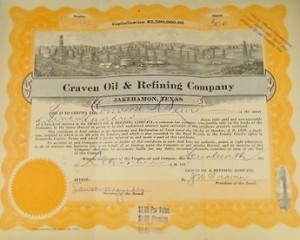Spear Oil Company
Speculators once again converged on a small town in Eastland County in 1918 as yet another West Texas drilling boom began with a gusher. Spear Oil Company soon joined them.
In September a well producing 2,000 barrels of oil a day had blown in near Desdemona, one of the first Texas towns established west of the Brazos River.

The Desdemona oilfield, Eastland County, Texas, circa 1919. Library of Congress Prints and Photographs Division, Washington, D.C.
Desdemona had once been called Hog Town and Hog Creek Oil Company made the discovery (not a skilled conman’s Hog Creek Carruth Oil Company). Eastland County’s Ranger and Cisco communities experienced drilling booms the previous year.
The “Roaring Ranger” McClesky No. 1 well of October 1917 had reached a daily production of 1,700 barrels. Within two years eight refineries were open or under construction and Ranger banks had $5 million in deposits. ALso in North Texas, a 1918 gusher created boom town Burkburnett.
That oil field gained international fame for Ranger as the town that wiped out oil shortages during World War I, allowing the Allies to “float to victory on a wave of oil.” Eastland County’s Cisco would later gain fame as the crowded boom town Conrad Hilton visited after the war — and bought his first motel (see Oil Boom brings First Hilton Hotel).
Spear Oil Company
Spear Oil Company organized with capitalization of $1.75 million in 1919 — the same year the Desdemona field reached its peak annual production of almost 7.4 million barrels of oil.
With J.A. Spear as president and leases to drill in Desdemona, widespread promotion of stock sales was necessary to fund the of Stephensville, Texas, based new venture’s operations. But at least one oil stock promoter who had misrepresented the value of the region’s wells in 1914 was serving time in federal prison.
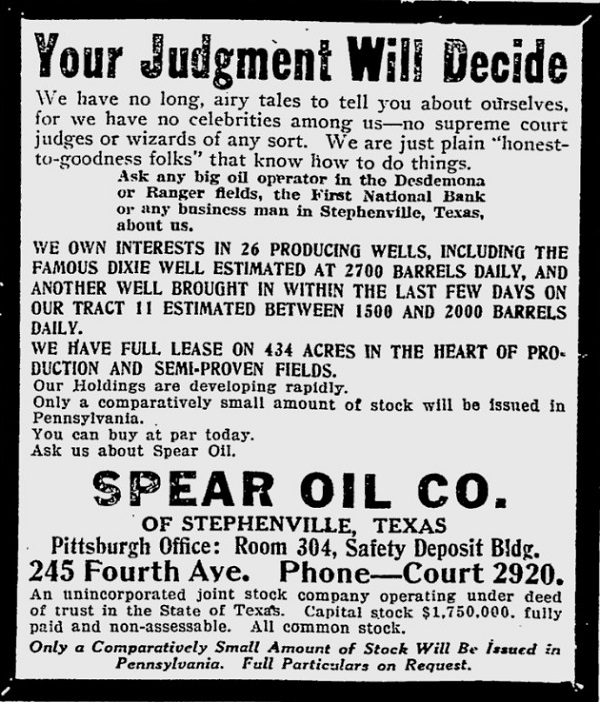 With oil stock promotions appearing in newspapers nationwide, states began taking action. In August 1919, the attorney general of South Carolina refused Spear Oil Company’s request to sell stock in his state because the company failed to comply with South Carolina “Blue Sky Laws.”
With oil stock promotions appearing in newspapers nationwide, states began taking action. In August 1919, the attorney general of South Carolina refused Spear Oil Company’s request to sell stock in his state because the company failed to comply with South Carolina “Blue Sky Laws.”
These new laws were designed to prevent the use of the U.S. Mail in stock promotion schemes. The South Carolina attorney general’s rejection excoriated the practice of “selling script or certificates of so-called ‘stock’ in the leasing and operation of what is claimed to be prospective development, producing and marketing of oil and gas in Texas.”
The trade publication United States Investor agreed. “We do not recommend Spear Oil as a purchase,” noted the magazine’s editors. “Apparently the people at the head of this company are much more at home selling stock than they are in operating an oil enterprise.”
Nonetheless, within a few months, a Wilmington newspaper published an “editorial” letter (no doubt paid for by the company) extolling Spear Oil Company properties.
Newspaper Ads and Editorials
“There are a number of wells being drilled on their royalties and several locations for wells on their solid leases,” the Wilmington Morning Star reported. “As a whole, we consider the securities of Spear Oil Company safe, with prospects for at least good, substantial dividends for many years and each of us has purchased a number of shares of their securities.”
The letter concluded: “In conclusion, we found the conditions and general outlook for the success of the company much better than we had expected, and even better than it had been represented to us. Respectfully submitted…”
Spear Oil did drill in Eastland County and complete oil wells. United States Investor was obliged to update and report net production of about 600 to 650 barrels per day from the company’s Desdemona operations in the southeast corner of Eastland County.
The company’s stock was still offered on the Fort Worth Exchange at $1.40 a share in September 1920, although it had not paid dividends and, “as yet and appears to be using its earnings for further development.” As far away as North Tonawanda, New York, promoters of Spear Oil wrote enthusiastic endorsements recommending the company’s stock.
Drilling a Well
In 1921, Spear Oil Company spudded its Blankenship No. 1 well, but soon shut it down and moved two strings of tools and three rigs to begin operations on another promising lease. The Blankenship No. 2 well’s progress was noted in oil trade publications.
“The Desdemona field now has approximately 315 completed wells that have a daily average production ranging from 4,000 to 6,000 barrels,” Oil Weekly reported on January 14, 1922.
“During the past week, the Spear Oil Company’s No. 2 Blankenship failed to show up as a producer after being shot with 20 quarts from 3,060 to 3,070 feet,” the publication added. “This well has a total depth of 3,085 feet, and is now being cleaned out.”
Learn more how a well was “shot” in Shooters – A Fracking History.
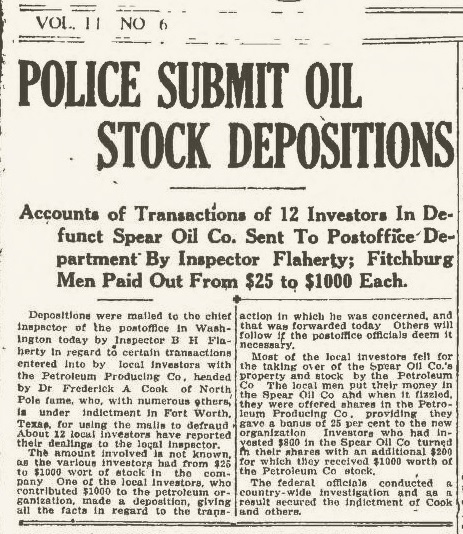
Meanwhile, the impact of over-drilling was clear as reservoir pressures and production from the field diminished. Spear Oil’s Blankenship No. 2 well failed along with many others and funding for continued operations could not be secured.
Stockholders of the failing Spear Oil Company were approached in 1923 by the famed (but fraudulent) North Pole explorer, Frederick Cook and his Petroleum Producers’ Association.
Cook’s stock manipulations and violations of blue sky laws ultimately landed him in prison, but not before many Spear Oil share owners were conned into exchanging their stock for Petroleum Producers’ Association while paying a 25 percent “bonus.”
Learn more about Cook in Arctic Explorer turns Oil Promoter.
Petroleum Producers’ Association stock was as worthless as Spear Oil Company’s, but investors were convinced otherwise, largely through the extraordinary promotional machinations of Seymour Cox. “Alphabet” Cox. The skilled huckster and others were convicted of ”dispersing stock-sales revenues as dividends, claiming income from non-producing wells, and otherwise misrepresenting the company’s position.”
Another notable fraudster, J.W. “Hog Creek” Carruth, created Pilgrim Oil Company and other shady oilfield ventures solely to bilk unwary investors.
It was not until 1934 that the Securities and Exchange Commission (SEC) was established to regulate the issue and sale of securities and to protect the public from increasingly clever stock promotions and manipulations. By then, Spear Oil Company was long gone. Its stock certificates may have value to scripophily collectors.
_______________________
The American Oil & Gas Historical Society preserves U.S. petroleum history. Join today as an annual AOGHS annual supporting member. Help maintain this energy education website and expand historical research. For more information, contact bawells@aoghs.org. Copyright © 2021 Bruce A. Wells. All rights reserved.
Citation Information – Article Title: “Spear Oil Company.” Authors: B.A. Wells and K.L. Wells. Website Name: American Oil & Gas Historical Society. URL: https://aoghs.org/oil-almanac/oil-riches-of-merriman-baptist-church. Last Updated: September 7, 2021. Original Published Date: February 1, 2014.
.



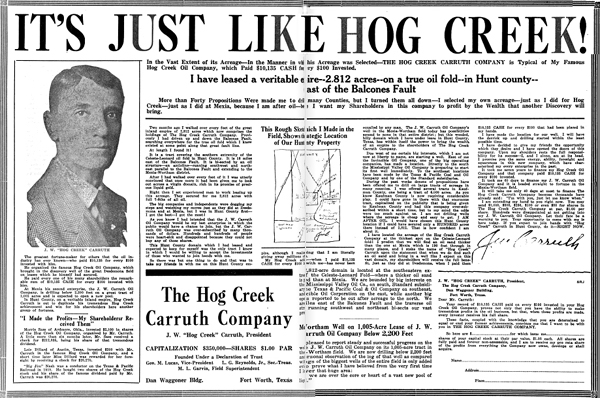
 After testimony from almost 300 witnesses and a lengthy trial, Carruth, Cook, Cox and others were convicted of “dispersing stock-sales revenues as dividends, claiming income from non-producing wells, and otherwise misrepresenting the company’s position.”
After testimony from almost 300 witnesses and a lengthy trial, Carruth, Cook, Cox and others were convicted of “dispersing stock-sales revenues as dividends, claiming income from non-producing wells, and otherwise misrepresenting the company’s position.”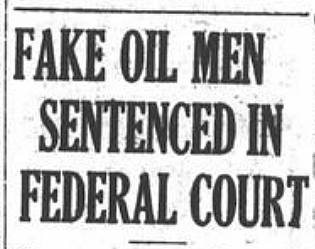 “Hog Creek” Carruth was sent to the Federal Penitentiary in Leavenworth, Kansas for a year. He died in obscurity in 1932.
“Hog Creek” Carruth was sent to the Federal Penitentiary in Leavenworth, Kansas for a year. He died in obscurity in 1932.
